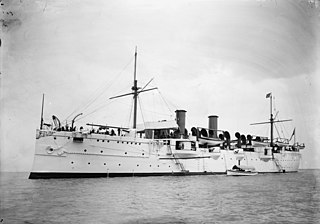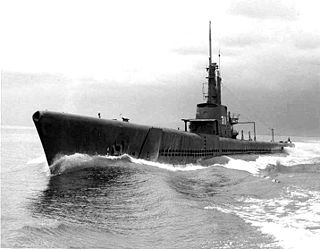
The third USS Charleston (C-22/CA-19) was a United States Navy St. Louis-class protected cruiser. She was launched 23 January 1904 by Newport News Shipbuilding and Dry Dock Co., Newport News, Virginia, sponsored by Miss Helen Whaley Rhett, and commissioned on 17 October 1905, Captain Cameron McRae Winslow in command. She was reclassified CA-19 on 17 July 1920.

The second USS Colorado (ACR-7/CA-7), also referred to as "Armored Cruiser No. 7", and later renamed Pueblo, was a United States Navy Pennsylvania-class armored cruiser. She was the second US Navy ship named Colorado, and the first to be named after the state of Colorado. The first, Colorado, was named for the Colorado River.

The fourth USS Philadelphia (C-4) was the sixth protected cruiser of the United States Navy. Although designed by the Navy Department, her hull was similar to the preceding British-designed Baltimore, but Philadelphia had a uniform main armament of twelve 6-inch guns.

The first USS Minneapolis (C-13/CA-17) was a United States Navy Columbia-class protected cruiser. She was named for the city of Minneapolis, Minnesota.

The USS St. Louis (C-20/CA-18), was the lead ship of her class of protected cruisers in the United States Navy. St. Louis was launched on 6 May 1905 by the Neafie & Levy Company, of Philadelphia, Pennsylvania. She was sponsored by Miss Gladys Bryant Smith and commissioned on 18 August 1906 with Captain Nathaniel R. Usher in command.

USS Bergall (SS-320), a Balao-class submarine in commission from 1944 to 1958, was the first ship of the United States Navy to be named for the bergall, a small fish of the New England coast. During World War II she made five war patrols between 8 September 1944 and 17 June 1945, operating in the South China Sea, Java Sea, and Lombok Strait and north of the Malay Barrier. During these patrols she sank two Japanese merchant ships totaling 14,710 gross register tons and one 740-displacement ton Imperial Japanese Navy frigate. She also damaged the Japanese heavy cruiser Myōkō, which was never repaired.

USS Archerfish (SS/AGSS-311) was a Balao-class submarine. She was the first ship of the United States Navy to be named for the archerfish. Archerfish is best known for sinking the Japanese aircraft carrier Shinano in November 1944, the largest warship ever sunk by a submarine. For this achievement, she received a Presidential Unit Citation after World War II.

USS N-2 (SS-54) was a N-class coastal defense submarine built for the United States Navy during World War I.

USS N-4 (SS-56) was a N-class coastal defense submarine of the United States Navy. Her keel was laid down on 24 March 1915 by Lake Torpedo Boat Company in Bridgeport, Connecticut. The N-boats built by Lake had slightly different specifications from the ones built by Seattle Construction and Drydock and are sometimes considered a separate class.

USS N-5 (SS-57) was a N-class coastal defense submarine of the United States Navy. Her keel was laid down on 10 April 1915 by Lake Torpedo Boat Company in Bridgeport, Connecticut. The N-boats built by Lake had slightly different specifications from the ones built by Seattle Construction and Drydock and are sometimes considered a separate class.

USS N-6 (SS-58) was a N-class coastal defense submarine of the United States Navy. Her keel was laid down on 15 April 1915 by Lake Torpedo Boat Company in Bridgeport, Connecticut. The N-boats built by Lake had slightly different specifications from the ones built by Seattle Construction and Drydock and are sometimes considered a separate class.

USS K-5 (SS-36) was a K-class submarine of the United States Navy. Her keel was laid down by the Fore River Shipbuilding Company in Quincy, Massachusetts, under a subcontract from the Electric Boat Company of Groton, Connecticut. She was launched on 17 March 1914 sponsored by Mrs. Warren G. Child, and commissioned on 22 August.

USS G-2 (SS-27) was a G-class submarine of the United States Navy. While the four G-boats were nominally all of a class, they differed enough in significant details that they are sometimes considered to be four unique boats, each in a class by herself. G-2 was named Tuna when her keel was laid down on 20 October 1909 by the Lake Torpedo Boat Company in Bridgeport, Connecticut, making her the first ship of the United States Navy to be named for the tuna, a large, vigorous, spiny-finned fish highly esteemed for sport and food. She was renamed G-2 on 17 November 1911, launched on 10 January 1912 sponsored by Ms. Marjorie F. Miller, towed to the New York Navy Yard after the termination of the Lake contract on 7 November 1913 where she was completed, and commissioned on 1 December 1913.

USS Fox (DD-234/AG-85) was a Clemson-class destroyer in the United States Navy during World War II. She was the fourth ship named for Gustavus Vasa Fox, Assistant Secretary of the Navy during the Civil War.

USS Kane (DD-235/APD-18) was a Clemson-class destroyer in the United States Navy during World War II. She was the first ship named for Elisha Kent Kane.

USS Savannah was a submarine tender in the United States Navy in World War I and the years after. She was launched 18 April 1899 as a German commercial freighter SS Saxonia, but was seized by the United States in 1917 and renamed Savannah. In 1933, the ship was renamed USS AS-8 to allow USS Savannah to have the Savannah name.

USS Manlove (DE-36) was an Evarts-class destroyer escort of the United States Navy during World War II. She was promptly sent off into the Pacific Ocean to protect convoys and other ships from Japanese submarines and fighter aircraft. She performed dangerous work in numerous battle areas, and was awarded five battle stars.

USS Swenning (DE-394) was an Edsall-class destroyer escort in service with the United States Navy from 1943 to 1946. She was sold for scrapping in 1974.
USS PC-817 was a PC-461-class submarine chaser built for the United States Navy during World War II. She was later renamed Welch (PC-817) but never saw active service under that name.

Puget Sound Naval Shipyard is a large military-industrial complex located in Bremerton, Washington along the north shore of Sinclair Inlet, which opens to Puget Sound. This large shipyard is 1.5 miles (2.4 km) in length along the shore and over a half-mile in width at its greatest distance across. The shipyard has nearly 1,000 facilities such as shipfitters shops, repair shops, drydocks, piers, cranes, crane rails, railways, and tunnels. In addition to the industrial facilities, supporting structures include: residences for officers and enlisted personnel, recreation facilities, boiler, electrical substations, fuel tanks, medical facilities, and canteens. The historic district is just over a tenth of the entire shipyard, 189 acres of the shipyard's 1,347 acres. Its greatest significance was during the Second World War when it repaired large warships damaged in the Pacific theater. It was designated a National Historic Landmark District in 1992.




















